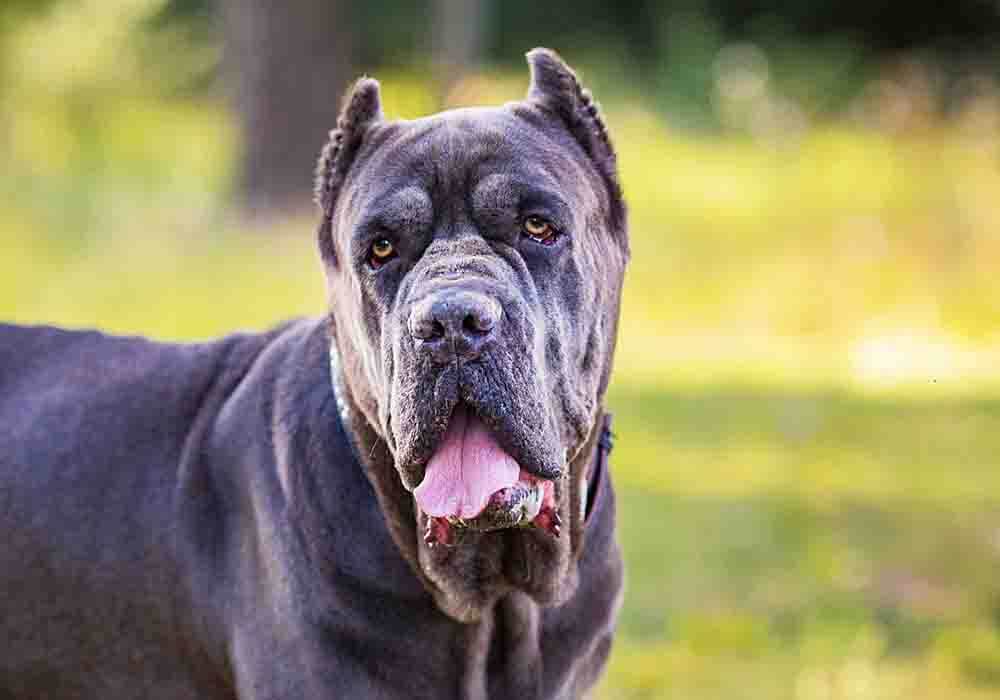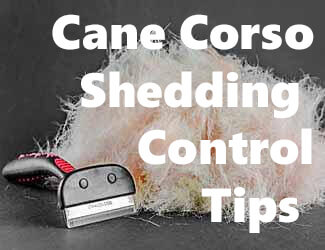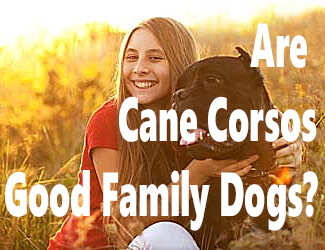Cane Corso Common Health Issues
And Problems
What Are The Risks, Symptoms and Treatment?
by Ken Alden
When it comes to Cane Corso common health issues and problems this dog is no different than most large breeds in that because of their large size they tend to have more health issues than smaller dogs.
Cane Corso Common Health Issues And Problems Include...
- Bloat, which is also known as Gastric Dilation Volvulus (GDV)
- Hip dysplasia which is painful and affects the skeleton
- Cherry eye which is a red swelling in the corner of the eye
- Entropion and ectropion which are irritating eye conditions
- General health issues such as cancer and allergies
Check with your breeder for any health problems, and know that purebreds will always be more at risk.
This article will cover some Cane Corso-specific health problems, as well as general concerns like cancer and allergies. It will list symptoms, treatment, risk, and prevention. It will also discuss the benefits of getting your Cane Corso health insurance. Read More Below...
Disclaimer: It should be mentioned that the owners and writers of this website are not trained veterinarians or pet doctors. The health information on this page is not meant as a diagnosis. If you have any questions about your Cane Corso’s health, always go to your veterinarian for help.
Pro-tip: Ever try lifting a Cane Corso? Their weight can hurt not only your back but their joints when they hop down from cars, sofas or even your bed. To protect your back and theirs check out the best Mastiff ramps on Amazon.com now.
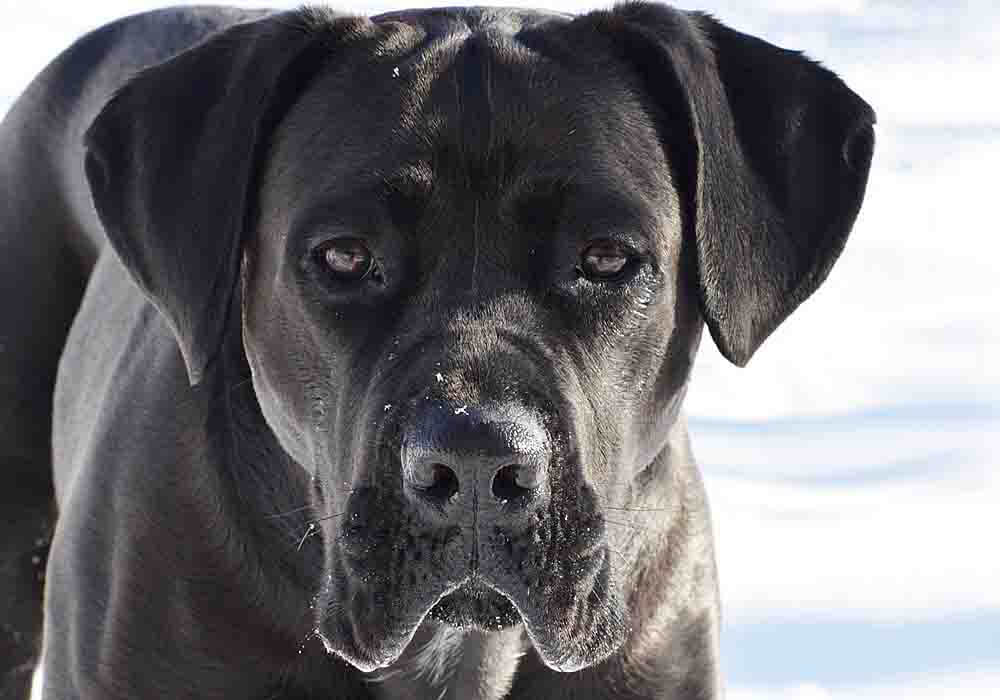
Bloat in Cane Corso
When it comes to Cane Corso common health issues and problems, Bloat is a biggie to watch out for. Bloat, also known as Gastric Dilation Volvulus (GDV), is a condition where a dog’s stomach fills up with air or fluid and twists itself. GDV starts as “simple bloat.” Simple bloat describes a situation when your pet’s stomach is too full of gas or food and expands alarmingly. This is not an immediate emergency and might pass on its own.
However, if the dog’s condition worsens, the stomach may twist and cut off blood flow to the other organs. This is known as GDV, and a bloated dog in this condition should always be taken to an emergency.
Cane Corso Bloat Symptoms
Recognizing bloat early is the key to getting it treated. The signs of bloat are:
- Pacing
- Swollen abdomen
- Pain in the abdomen
- Dry heaving
- Excessive drooling
- Inability to stand up
- Panting
Treatment of Bloat
During “simple bloat,” when the stomach still hasn’t flipped, bloat can still be treated with pain medications. Once it has flipped and become GDV, surgery is required.
Surgeons untwist the stomach and investigate the amount of damage caused by a lack of blood flow. A gastropexy is also done, in which the stomach is attached to the abdomen walls to prevent GDV in the future.
How It’s Treated
Bloat happens when a lot of food or water, along with a lot of gas, is ingested at once. Some ways to prevent bloat are:
- Feeding dogs smaller meals more frequently
- Not letting your dog drink a lot of water at once
- Not using raised dog bowls
- Not letting your dog exercise heavily after a meal
Learn more about Mastiff bloat in this helpful article of ours here.
Hip Dysplasia in Cane Corso
When it comes to Cane Corso common health issues and problems hip dysplasia is a painful condition affecting the skeleton and is more common in large dogs. It affects dogs of any age and may also bring on osteoarthritis.
Cane Corso Hip Dysplasia Symptoms
- The dog does not want to exercise
- Limited range of motion
- Stiffness
- Lame back legs
- Difficulty jumping, running, or climbing stairs
- Irregular gait
- Loss of hind leg muscles
- Growth of front shoulder muscles to compensate for weak back legs
Cane Corso Hip Dysplasia Treatment
Hip dysplasia can be treated both surgically and non-surgically, depending on its severity. Non-surgical treatments include:
- Weight reduction diets
- Restricting exercise on hard surfaces
- Joint supplements
- Anti-inflammatory medications
There are also several surgeries to help with hip dysplasia. They are chosen depending on the age of the dog.
- Double pelvic osteotomy (DPO): This surgery involves cutting the pelvic bone of dogs under ten months of age to improve movement.
- Femoral head ostectomy (FHO): This is a pain management surgery that involves cutting off the ball of the hip joint, reducing chafing and pain. It can be performed on young and adult dogs alike.
- Total hip replacement (THR): This surgery is exactly what it sounds like: the entire hip joint is replaced with a metal implant, allowing for the dog to move normally again. This is only performed on fully-grown dogs.
Preventing Cane Corso Hip Dysplasia
The most important factor that can prevent hip issues in Cane Corsos is feeding. During puppyhood, the Cane Corso should be fed puppy food made specifically for giant dogs. This sort of food stops your pup from growing too fast and becoming too heavy for its bones.
As adults, Cane Corsos should be fed a healthy diet to prevent obesity. Food supplements like glucosamine can also help reduce the chances of dysplasia. When adopting dogs, it is good to check whether they have OFA or PennHIP clearances for hip dysplasia.
Dysplasia Risk Factors
Obesity, too much or too little exercise, and excessively speedy growth can result in hip dysplasia. Giant dogs are the most at risk because their huge weight puts so much strain on their bones. cane corso common health issues and problems
We have a more in depth article on hip dysplasia in this article of ours here.
Pro-tip: Cane Corso anxiety, aggression, destructive chewing, jumping up, fearfulness, and other behaviors can be controlled with the right training program.
Here’s a great course that
addresses these issues along with many other dog training basics: Check it out now!
Cane Corso and Cherry Eye
All dogs have three eyelids, the third of which is found beneath the eye. That eyelid is home to the nictitating gland, which produces tears. Cherry eye is a genetic eye problem in which the nictitating gland prolapses and creates a swollen red mass in its place.
Cherry eye is not dangerous in itself but has a lot of possible complications. Cherry eye leaves the eye open to other infections and causes dry eye (keratoconjunctivitis sicca), which can cause blindness.
Cane Corso Cherry Eye Symptoms
- Red oval swelling in the corner of the eye
- Dog pawing its face or rubbing it on the carpet
- Excessive teariness
- Inflamed eye tissue
- Squinting
Cane Corso Cherry Eye Treatment
Cherry eye can be initially treated with antibiotics, but surgery will eventually be needed.
There is some controversy on how to treat cherry eye in large dogs. Veterinarians typically treat cherry eye by sewing the inflamed gland back into place, in a procedure called “tacking.” A new surgery called imbrication or “pocketing” has tissue put over the gland to cover it up. An alternative used by breeders is to have the gland removed entirely.
There are cons to every form of treatment. Gland removal can lead to permanently dry eyes, which will require lifelong treatment with eye drops, although many Cane Corsos are prone to that already. Untreated dry eye can lead to blindness.
Tacking only holds 25% of the time and may need to be repeated. If the stitching comes undone, it can scratch the dog’s eye. Repeated tacking can end up disfiguring a Cane Corso’s face, not to mention cause distress at every new surgery.
Pocketing can lead to eye swelling. If the stitches aren't properly tightened, the cherry eye may return. Consult your veterinarian to see which surgery is best for you.
How to Prevent Cherry Eye
Cherry eye is unfortunately not preventable. The best you can do is make sure potential puppies’ parents were checked by the Canine Eye Registry Foundation before adopting.
Cherry Eye Risk Factors
Being genetic, cherry eye is determined by your dog’s parentage. It is most often seen in young dogs, up to 2 years of age.
Entropion and Ectropion in Cane Corso
Cane Corso common health issues and problems can unfortuneatly be many and Entropion is one of them. This is an eye condition in which the eyelid rolls in on itself, causing the dog’s lashes to repeatedly scratch at the cornea. Ectropion is entropion’s opposite: the dog’s eyelid rolls outwards, exposing its sensitive lining to damage.
Entropion and ectropion can both be either inherited or acquired. Inherited entropion/ectropion is genetic, while acquired entropion/ectropion is caused by injuries to the eye.
Cane Corso Entropion Symptoms
- Squinting
- Keeping the eye shut
- Inflamed eyelids
- Excessive tears
- Eye discharge that may stain fur under eyes brown
- Scratching at the face
Cane Corso Ectropion Symptoms
- Sagging of the lower eyelid
- Inflamed eyelids
- Excessive tears
- Eye discharge may stain fur under the eyes
How It’s Treated
Entropion and ectropion are both treated with two corrective surgeries, which involve cutting off the part of the eyelid that is rolling inward or outward. There are two surgeries instead of one to avoid cutting off too much and having the dog develop the opposite condition instead.
Prior to surgery, ointments and antibiotics may be given to fight dryness and ulcers.
How to Prevent Entropion/Ectropion
Inherited entropion can be prevented by rolling the skin around a dog’s eyes outwards a few times each day. That will stretch the skin away from the eyeball.
To avoid acquired entropion/ectropion, make sure your dog does not injure its eyes: keep it on a leash.
Entropion/Ectropion Risk Factors
Inherited ectropion/ectropion is most common in dogs with excessive folds around the eye. It can come to dogs of any age.
When adopting a Cane Corso puppy, choose one that comes from less wrinkly parents. Dogs you are planning to adopt should have their parents checked by the Canine eye registry foundation for any eye problems.
Pro-tip: Cane Corso's (and their owners) love dog crates…and for good
reasons. Crates keep dogs from mischief while you're away, are perfect for house
training, for traveling by car, and provide the dog a place to de-stress. Check
out the best Mastiff crates on Amazon.com now.
Cancer in Cane Corso
Cane Corsos are as prone to cancer as any other dog. Listed below are the five most common dog cancers, their symptoms, and treatment.
Mast Cell Tumors
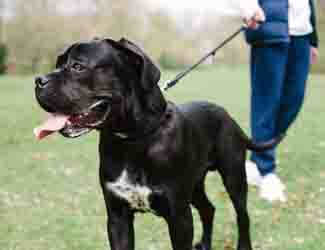
Mast cell tumors are a kind of skin cancer that forms nodular tumors, most often on the skin. They can also form on connective tissues in the lungs, skin, nose, and mouth. They may be raised or under the skin and can grow or stagnate unexpectedly. MCT can also cause stomach ulcers, vomiting, loss of appetite, and black stools.
Low-grade mast cell tumors can be treated by simple removal. If there is evidence of spread, however, chemotherapy will be necessary.
MCTs are known for being mistaken for insect bites or warts. It is important not to let the god lick or paw at the tumor: touching the tumor may cause the mast cells to release histamine, an allergy compound that can lead to anaphylactic shock.
Melanoma
Melanoma is the most common mouth tumor found in dogs. As a tumor in the mouth, it has a terrible tendency to spread. 80% of dogs who will have had the oral tumor removed will develop cancer in other parts of their bodies. It can also appear in the nailbed, eye, or as a dark spot on the skin.
Melanoma is best treated by immediate tumor removal, followed by treatment with the melanoma vaccine to prevent spread.
Lymphoma
Lymphoma is the cancer of the lymphoid tissues found in the bone marrow, spleen, skin, or lymph nodes. The most common type of lymphoma that constitutes 85% of cases is multicentric lymphoma.
Multicentric lymphoma is heralded by the sudden growth of the lymph nodes, found in the armpits, neck, and groin of the dog. This early stage is non-painful. In later stages, the dog may show signs of ill health, like lack of energy, fever, dehydration, and no desire to eat.
Multicentric lymphoma can be successfully treated in 90% of cases with chemotherapy.
Osteosarcoma
Osteosarcoma, also known as bone cancer, is more common in giant breeds like the Cane Corso. It usually is seen in the legs but can also sometimes be found in the ribs or skull. Signs of osteosarcoma are painful red swelling on the bone and occasional lameness. Pain from osteosarcoma can initially be treated with painkillers, but not for much more than a week.
Treatment or osteosarcoma must deal with both the primary tumor and the secondary spread: unfortunately, osteosarcoma spreads easily through the blood. Amputation is the usual treatment for a tumor in the limb, although, in certain locations like the wrist joint, the tumor can be removed and replaced with a titanium implant.
Both amputation and replacement are usually associated with chemotherapy to deal with any possible spread remaining in the body.
Hemangiosarcoma
Hemangiosarcoma is a fast-moving and very dangerous type of cancer, found almost exclusively in dogs. It affects the blood cells, causing them to build malformed blood vessels that eventually get clotted and burst. Often found in the heart or spleen and virtually painless, hemangiosarcoma is usually already in its late stages when diagnosed. cane corso common health issues and problems
There are few effective treatments known for hemangiosarcoma: testing is difficult and only works on very large tumors. Surgery and chemotherapy may be attempted, but only extend the dog’s life by perhaps 180 days.
Cane Corso Common Allergies
Like any dog, Cane Corsos can develop allergies. Allergies range from mild, causing itchiness and redness, to severe, causing bowel issues and infections.
Cane Corsos have many of the same allergies as humans do, including:
- Environmental: Fleas, grass, pollen
- Foods: Wheat, chicken, soy
- Medicines: Penicillin, Opiates
- Scented or chemical products: Perfumes, shampoos, cleaning products, latex
Cane Corso Allergy Symptoms
- Dry skin
- Watery eyes
- Discharge from nose
- Ear inflammation, itchiness, or redness
- Toe inflammation or redness
- Chronic ear infections
- Diarrhea
- Vomiting
- Breathing problems
How They’re Treated
If you suspect an allergy in your dog, the first thing to do is go to the vet to properly diagnose it.
Flea allergies are diagnosed by applying flea treatments and seeing if the symptoms stop. To diagnose food allergies, your dog must go through an elimination diet, in which it eats one food at a time to test its reaction. Product allergies are identified through patch tests on the dog’s skin.
Omega-3 fatty acid supplements may help build up your dog’s skin and reduce redness and itching.
Health Issue
GDV (Bloat)
Hip dysplasia
Cherry eye
Ectropion
Cancer
Overall Risk
Medium
High
High
Medium
Medium
Risk Factors
- Middle-aged and older dogs
- Fast eaters
- Dogs using raised feeding bowls
- Genetic predisposition
- Obesity
- Too much / too little exercise
- Excessive growth
- Genetic predisposition
- Young dogs under 2 years of age
- Genetic predisposition
- Face shape
- Injuries
- Old age
- For Osteosarcoma - weight
Should I Consider Health Insurance for My Cane Corso?
A Cane Corso can cost, on average, $900-$2,000 to buy. If it has an exceptional lineage, that price can be even higher, $2,500-$8,500. Including feeding costs, your dog represents a serious investment.
Vet bills can also go very high. It can cost $195-$250 to do an allergy skin test, $400-$1,000 for heartworm treatment, and $1,500 just to diagnose cancer in your dog. Considering this and all the health problems that can befall a Cane Corso, it may be wise to have a safety net.
Pet insurance provides just that: for an average of $43.00 a month, you can get 90% of your vet bill reimbursed. For something like GDV surgery, which can cost $2,500-$5,000, this would make a big difference in your finances.
Make sure to see our review of the top 3 pet insurance providers, policies and pricing when it comes to insuring your Cane.
Cane Corso Common Health Issues And Problems...Final Thoughts
Cane Corsos are susceptible to many of the health issues that other dogs have: ectropion, cancer, allergies. They also have several health problems specific to them, like GVD, hip dysplasia, and cherry eye.
Many of these issues have to be treated with surgery, and allergies may require extensive testing. Any of these can create some serious vet bills. For this reason, it might be prudent to invest in Cane Corso health insurance. Depending on your dog’s age, value, and health, insurance may offset up to 90% of vet bills and protect your furry friend.
Return to the top of this Cane Corso Common Health Issues And Problems page

About the Author...
Ken Alden, a dedicated Mastiff owner for over eight years, is acclaimed for his expertise in care, grooming, and training. Read more About Me and my dog Shadow.
- Mastiff Guide Home ›
- How To Take Care Of A Cane Corso ›
- Cane Corso Common Health Issues And Problems

